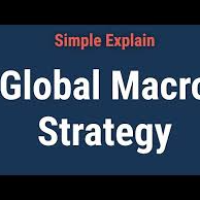Key Elements of Global Macro Strategy :
1. Understanding Global Macroeconomic Trends
* Economic growth : GDP growth rates are crucial for assessing economic health. For instance, a strong growth outlook in the U.S. might lead to bullish equity positions, while weak growth in Europe could prompt short positions or defensive investments.
* Inflation : Central banks adjust interest rates in response to inflation, impacting bond yields and currency values. For example, rising inflation in the U.S. led to increased interest rates, affecting bond markets and currency exchange rates.
* Interest : Changes in interest rates influence borrowing costs and consumer spending. Expectations of rate hikes or cuts can lead to strategic shifts between stocks and bonds or currency trading.
2. Geopolitical Analysis
* Political Risk : Hedge funds analyze geopolitical risks like elections and trade wars, which can impact market stability. For example, uncertainty around U.S. elections often leads to increased market volatility.
* Trade Policies : Changes in trade agreements or tariffs significantly affect certain sectors or countries. Hedge funds may capitalize on trade tensions by investing in domestic companies that benefit from reduced competition.
3. Asset Allocation across different asset classes & sectors
* Diversification : Global macro strategies involve investing across diverse asset classes and geographic regions to spread risk and capitalize on emerging trends. For instance, investing in Asian markets during growth periods while focusing on U.S. consumer staples during downturns.
* Sector Rotation : Hedge funds rotate between sectors based on macroeconomic outlooks, favoring technology during growth periods and consumer staples during downturns.
4. Risk Management & Volatility Analysis :
* Stress Testing & Scenario Analysis : Given the uncertainty in macroeconomic forecasts, hedge funds conduct stress testing and scenario analysis to understand potential portfolio vulnerabilities.
* Dynamic Position Strategy : They adjust position sizes based on changing volatility, applying risk management strategies that consider various macroeconomic outcomes.
Statistics and Global Data :
-
Performance : In recent years, some macro hedge funds have delivered substantial returns. For example, Chris Rokos's hedge fund achieved a 30.7% annual return in 2024 through successful macroeconomic investments.
-
Market Conditions: The quantitative easing era following the 2008 financial crisis created less favorable conditions for global macro managers due to low volatility and central bank interventions. However, these strategies remain valuable for portfolio diversification and alpha generation over a complete market cycle.
-
Investment Trends : Hedge fund investors increasingly prefer macro strategies due to anticipated market changes resulting from political and economic policies under current administrations.
Conclusion
Global macro strategies empower hedge funds to capitalize on large-scale economic and geopolitical trends, offering a dynamic approach to investment decision-making. While rewarding, this strategy requires expertise in economic theory, financial analysis, and risk management. Hedge funds must remain adaptable to changing market conditions, continuously monitoring influences that impact their investment landscape. This adaptability positions them to capitalize on both emerging opportunities and potential risks on a global scale.

